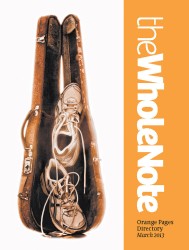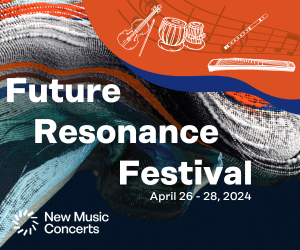Congratulations on breaking through the “Education Barrier” at last! The inaugural version of the Orange Pages in your March 2013 issue is a long-awaited step forward for your magazine, and for all of us in the GTA who have come to depend on its monthly calendar of musical events. Great to see the less glamorous but still essential activities of teaching and learning finally represented — so readably, and nicely illustrated too — as an integral part of The WholeNote.
Almost every one of your readers, I would bet, is involved somehow or other in music education. These days, most working musicians, whatever their specialty, probably derive at least part of their livelihood from giving music lessons; while the number of publicly or privately supported schools offering music instruction in every corner of the GTA seems to increase each year. Anyone attempting an exhaustive catalogue of musical training opportunities here would probably need a whole volume of orange-hued issues to cover them all.
Useful lists, after all, are what The Wholenote has always been about. Will this new one emulate the paid self-advertising familiar from the Yellow Pages, or favor capsule reviews in the manner of Toronto Life’s restaurant guide? For whose benefit is the information being organized and presented? And how will the editors decide who is or is not included?
A look at the headings under which list entries are grouped reveals more problems. Accomplished musicians, like any artist, tend to think of themselves as unique; in any case, what they have to teach is seldom limited to a single genre, style, instrument, or musical skill. Without cross-listing, or a pretty extensive set of partially overlapping categories — probably even more than your Discoveries section now manages with — it becomes difficult to recognize which individuals or schools offer comparable training, or find those most likely to match the interests of a particular student.
This first Orange Pages directory starts with 18 listings under “Community Schools”, and moves on to “Private Instruction” — only 16 of these — before ending with a few of the special “Summer Music Programs” that offer opportunities for study (as distinct from summer festivals, which belong instead on June’s Green Pages). If, for example, all we’re looking for is a piano teacher for our kids, located somewhere near our neighborhood, that should be easy enough to find from the information given. Differences in pedagogical approach, repertoire, cost or quality of instruction, however, are harder to tease out from the accompanying blurbs.
What does it take, one wonders, to qualify as a “community” music school in the Orange Pages? At least three of the 16 schools listed under this category are really private teaching studios, to judge from the blurbs. Others emphasize accessibility, and two of these along with another not yet on your list, but featured in an article elsewhere in the same issue — are evidently dedicated to reaching “youth in need” in “high-priority areas”, “regardless of ability to pay”, proposing participation in group music-making as a surefire remedy for poverty and gang violence. How such ambitious enterprises may actually resemble or differ from one another in practice, and how each manages to fund its charitable intentions, is not disclosed, though this would certainly be of interest to your readers, and to prospective donors as well.
These days, of course, the public purse still supports almost all types of music instruction in one way or another, if not as generously as we would like. The offering institution may be directly funded by government or arts council grants, or its support may come indirectly through children’s arts tax credits or charitable gift tax writeoffs. Lately, it appears private donors and foundations are increasingly catching on to the advantages of giving to programs that address the musical needs of disadvantaged youth.
Unfortunately, such programs are severely restricted in how they can spend or invest the money they receive, precisely because they are charities. The donor may gain a prestigious reputation for philanthropy, and sometimes considerable influence over what is or is not being taught. But the dedicated musicians who operate or teach in such “special” after-school programs have to settle for chronically lower salaries and fewer perks than their unionized or tenured counterparts in regular school and college jobs. (This could be one reason why regular teaching jobs for music specialists, along with the well-established public-school music courses most Toronto parents used to rely on, have lately become so scarce.)
Do we really believe that musical training is the birthright of the ambitious and the well-heeled, while kids from low-income families may enjoy its benefits only thanks to the generous impulses of our most prosperous citizens? Can such an uneasy arrangement really deliver the educational and personal value claimed for these charitable programs, or enable quality music instruction to reach enough of those children who need it most? Or is it perhaps time to put music back into the mandatory school curriculum, in recognition of its potentially vital contribution to every child’s mental and spiritual growth?
Instead of just complaining, a number of Toronto’s leading musicians, teachers, and presenters have been remarkably resourceful in devising new ways to fill the education gap. Major performing organizations such as Tafelmusik, Soundstreams, the COC, and the Toronto Symphony now regularly produce imaginative “outreach” programs aimed at targeted area schools. Most tend to be one-shot deals linked to their own upcoming productions, with limited carryover from one visit to the next. But they certainly do contribute to building tomorrow’s concert audiences; and without them, no institution’s grant application these days can hope to succeed. (Even more elaborate ways for top-drawer professional performing forces to enrich the musical experience of Toronto’s kids may be in the works. See, as an example, the TSO’s recent year-long collaborative composing project with Tod Machover of MIT, culminating in the March 9 premiere of A Toronto Symphony, well publicized in your February issue and elsewhere.)
Missing in this first instalment of the Orange Pages, but already scheduled for a later issue, is a rundown of the degree-oriented music instruction offered by local conservatories, colleges, and universities. Also to come, one hopes, is an inventory of music programs operated by elementary, middle, and secondary schools across the city, whether public, private, or specializing in the arts — or at least some indication of where the more extensive and better equipped programs can be found.
Is it possible, one wonders, to produce a directory that will truly help us evaluate the teachers themselves? A degree or diploma from some reputable institution of higher learning is usually accepted as sufficient evidence that a music teacher has acquired the necessary skills and background to do a competent job. To be sure, one can imagine a stricter system of accreditation, both for teachers and for the schools they attended. But there’s no guarantee that a uniform rating scheme would do much to improve the overall quality of instruction. By and large, Toronto seems to prefer the present competitive free-for-all. Culture, we recognize, is no zero-sum game; even when money is tight, “the more, the more” remains our motto, and “diversity” our watchword.
Like other strands in the intricate network of connections that is Canadian culture, what and how our musicians teach is bound to keep evolving, and remain open to all sorts of change. The range of styles, activities and interests associated with the word “music” keeps growing wider and more complex; while the whole enterprise of learning or schooling seems to be fair game, these days, for every would-be reformer. As we would any other addictive substance said to be good for us and our children, we will surely continue to question each new educational model, method, or system that claims our attention and support.
How well does the latest pedagogical project reflect our present-day aspirations to ensure equal opportunity for all, while respecting individual differences? Is it open to new repertoire and new modes of musical expression, or does it merely recycle familiar old habits, albeit substituting kid-sized violins or plastic recorders, perhaps, for the legendary “76 Trombones” of yore? Is there perhaps too much emphasis on training for public performance, at the expense of more analytical, historical, or creative approaches? Is intelligent use made of recent developments in educational media? Dazed by the perennial appeal of whatever “comes from away”, are we forgetting or ignoring pedagogical innovations that visionary Canadian educators have already pioneered and expounded here?
Clearly, to survey critically the full range of opportunities our region now offers for serious music study would be no easy task. The WholeNote was smart enough to tackle, at first, only a small and relatively manageable portion of the job. One can hardly ask more from a free publication that fulfills so many other life-supporting functions so well, with such limited financial resources. And yet, your magazine dares to envision producing, someday, a complete guide to the whole spectrum of our city’s resources for the care and training of its aspiring music-makers.
Here is one place where technology might make a real difference. A good deal of relevant information is already out there in cyberspace, on various individual web sites. It shouldn’t be all that expensive to solicit a more inclusive set of submissions from a much broader range of sources, organize them into one centralized database, and make sure the information is reasonably comparable, easily searchable, and widely accessible. Are you listening, Ontario and Toronto Arts Councils?
Anyway, thanks, David, for landing the first stone, right on target.
—Sterling Beckwith




